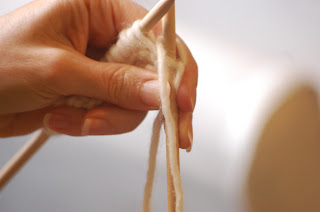to stay abreast of a new website, coming soon, that will give you everything you need to know to teach children to knit, and support you and your children in a developmental, imaginative, gentle way. Patterns and stories included.
Before learning to knit, I treat the children to a story (which I hope to type out tomorrow). The story sets the stage for their knitting skills, puts them in a listening place, and allows for a "sleeping". In other words, they take in information from the story, let it rest for a day or two, and then we proceed with knitting.
After we have cast on 12 stitches for a Curly Cat, it is time to make our first stitches. I use the poem, "In through the front door, run around the back, peek through the window, off jumps Jack."
Lift the latch first.
In through the front door by taking the needle from front to back, and through the first loop.
Drop your right hand for now and hold the "X" in your left hand.
Take your right hand and "stir the pot", meaning, take the yarn in your hands, and draw an imaginary circle around the needle, moving from right to left.
The pot has been stirred and now the yarn is hanging in between the two needles, in front.
Now, take right hand Pointer finger and place him directly on the yarn that was hanging, sandwiching it in between pointer and the needle. (I say, 'snug Jack up- he's cold')
Keeping your hands loose so you can place the tip of the right hand needle on the shaft of the left hand needle, and keeping Jack snug (this is the tricky part) "tickle, tickle" your way down the shaft and under the loop. The tip of right hand needle travels down as it tickles the left one. It will, naturally, come under the left-needle loop.
tickle tickle!
Now push the tip through and up, and with a smooth motion, move the stitch (yes, you just made a stitch!) to the right and off the needle. But just one!
Off jumps Jack!
Now repeat with the remaining stitches on the needle.
When all the stitches have been transferred to the other needle , switch hands and begin again. The last and first stitches are hard for children...teach them to make the first and last stitches a bit more snug. Keep the work pointing down and it will be easier to get in that first front door.
Repeat forever and ever and ever until you have effectively established a good knitting rhythm, and a very nice knitting habit.
(thank you, Kristin, my dear, beloved friend and now hand model.)






















